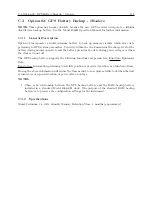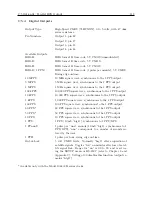
C.5 Option 04: Parallel BCD Output
123
Parallel Data Output Mode
Full operation in the parallel data output mode utilizes all 50 contacts of the output connector.
However, use of any combination of digital signal outputs or analog signal outputs will reduce the
number of data bits available by up to four (data bits 19, 27, 44, and 45). For details, refer to the
sections pertaining to these individual functions.
The functions of the individual data bits are defined for specific customer applications, upon request.
To configure Option 04 for parallel data mode, observe the following steps:
a. Set jumper JMP1 to position ”B”. This jumper enables the parallel data output mode.
b. Set jumpers JMP2, JMP3, JMP4, JMP5, and JMP11 to position ”A” (these settings will
vary if the analog and/or digital signal outputs are used; refer to the applicable sections for
more information on these functions).
c. If it is desired that the parallel output data be synchronous to the 1 PPS output, set jumper
JMP6 to position ”A”; for non-synchronous operation, set this jumper to position ”B”.
Digital Signal Outputs
The four digital signal outputs can be individually enabled and configured, using the following
steps:
a. Set jumper JMP11 to position ”A”. This enables the digital signal output mode. At the
same time, making this jumper selection eliminates parallel data bits 19, 27, 44, and 45.
b. To enable digital signal output number 1, set jumper JMP2 to position ”A”.
c. To set the type of output signal for digital signal output number 1, make the appropriate
selection on jumper JMP8 (refer to Figure 2). Note that positions 1 and 2 correspond to
analog signal outputs, and will be occupied by a jumper only if analog signal output number
1 is enabled.
d. To enable digital signal output number 2, set jumper JMP3 to position ”A”.
e. To set the type of output signal for digital signal output number 2, make the appropriate
selection on jumper JMP7 (refer to Figure 2). Note that positions 1 and 2 correspond to
analog signal outputs, and will be occupied by a jumper only if analog signal output number
2 is enabled.
f. To enable digital signal output number 3, set jumper JMP4 to position ”A”.
This also
eliminates the possibility of using analog signal output number 1.
g. To set the type of output signal for digital signal output number 3, make the appropriate
selection on jumper JMP9 (refer to Figure 2).
h. To enable digital signal output number 4, set jumper JMP5 to position ”A”.
This also
eliminates the possibility of using analog signal output number 2.
i. To set the type of output signal for digital signal output number 4, make the appropriate
selection on jumper JMP10 (refer to Figure 2).
Summary of Contents for 1088A
Page 4: ...iv ...
Page 6: ...vi ...
Page 18: ...xviii LIST OF FIGURES ...
Page 23: ...1 4 Attaching Rack Mount Ears to 1088A B Series Clocks 3 Figure 1 2 Attaching Rack Mount Ears ...
Page 24: ...4 Unpacking the Clock ...
Page 32: ...12 Front and Rear Panels ...
Page 38: ...18 Connecting Inlet Power Input and Output Signals ...
Page 46: ...26 GPS Antenna and Cable Information ...
Page 48: ...28 Setting Internal Jumpers Figure 5 1 Model 1088B Main Board ...
Page 76: ...56 The Setup Menus ...
Page 112: ...92 Serial Communication and Command Set ...
Page 127: ...B 4 Physical Dimensions 107 Figure B 1 Suggested Mounting of the AS0094500 Surge Arrester ...
Page 128: ...108 Using Surge Arresters ...
Page 145: ...C 5 Option 04 Parallel BCD Output 125 Figure C 4 Option 04 Output Jumper Settings ...
Page 146: ...126 Options List Figure C 5 Option 04 Board Layout and Jumper Locations ...
Page 166: ...146 Options List Figure C 12 Option 17 Board Layout and Jumper Locations ...
Page 187: ...C 16 Option 20A Four Fiber Optic Outputs 167 Figure C 22 Option 20A Jumper Locations ...
Page 194: ...174 Options List Figure C 24 Option 23 Internal Jumper Setup ...
Page 196: ...176 Options List Figure C 25 Option 27 Jumper Locations ...
Page 214: ...194 Options List Figure C 28 Option 29 Connector Signal Locations ...
Page 270: ...250 Options List ...






























